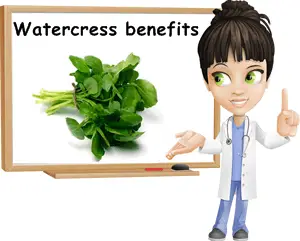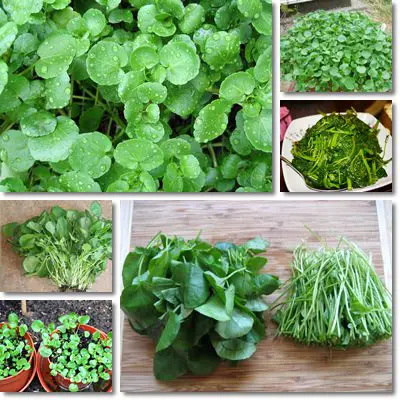Like most green leafy vegetables, watercress (Nasturtium officinale) is a blessing for one’s health, promoting good vision, strong bones and teeth and supporting both heart and blood vessel activity. Regular consumption provides great health benefits due to increasing one’s vitamin and mineral intake. The vegetable stands out from a nutritional point of view as a rich source of vitamins A, C and K, but also contains notable amounts of B vitamins, calcium, phosphorus and potassium.
What is watercress?
Well, watercress is a semi-aquatic leaf vegetable with an above-average nutritional profile as well as a high culinary versatility. It is related to mustard, radishes and wasabi with which it shares common features, notably delicate pungent flavors. However, watercress may be a source of side effects when consumed in excessive amounts or too frequently and is contraindicated for anyone receiving blood thinning medication to treat blood clots.

What does watercress look like?
As you can see from the compilation of images below, watercress is a green leafy vegetable with thin, rounded, deep green leaves. The leaves are consumed whilst still young and small and are quite similar in texture to spinach leaves. The plant has greenish hollow stems and, if left to mature, it can easily reach heights of above 50-100 cm. It’s grown in water, with the hollow stems floating above.
What does watercress taste like?
Just like mustard, radishes and wasabi, watercress has a more or less peppery taste. The age of the plant determines taste intensity. In other words, if picked while still young and tender, watercress has a milder pungent taste. If left to mature, it will turn quite pungent and exhibit bitter flavor notes. Watercress turns bitter around the time it starts producing flowers. The vegetable can be consumed both fresh and cooked, but does not last very long stored. Fresh leaves tend to have a cooling effect, despite being pungent. Watercress can be added to virtually any recipe, from soups and stews to risotto, braised chicken, salads, sandwiches and stir fried vegetables.

What are the benefits of watercress?
What is watercress good for? Find out below its most notable 8 nutrition facts and health benefits:
Good for weight loss
Watercress contains only 11 kcal/100 g and is 95.11% water. Eating it on a regular basis not only helps hydrate the body, but also helps one lose weight safely by restricting caloric intake while supplying significant amounts of important nutrients, essential for good metabolism.
Improves visual acuity and night vision and supports retina health
Rich in vitamin A as well as carotenoids with both antioxidant and vitamin A activity (beta-carotene, lutein, zeaxanthin), watercress promotes eye health and helps maintain good vision. A generous intake of vitamin A improves visual acuity (vision clearness) as well as night vision (more exactly, the ability to see in low light). Carotenoids such as lutein and zeaxanthin are deposited in and employed by the retina for protection against free radicals from light. A sufficient dietary intake throughout one’s life is believed to lower cataract as well as macular degeneration (loss of central vision) risks.
Stimulates immunity
The high amounts of vitamin A (106%) in watercress ensure the health of the mucous membranes at the level of the nose, mouth, throat, lungs and digestive tract, the parts in direct contact with the outside world and its pathogens and thus the ones most exposed to infection. Vitamin C, also found in great amounts in watercress (72%), stimulates the immune system to respond better to viral and bacterial infections.
Improves skin appearance
Vitamin C stimulates the production of collagen, a principal structural protein in our body responsible for blood vessel, skin, etc. integrity. In other words, having generous amounts of vitamin C in our body should delay wrinkles and sagging skin and help maintain a youthful skin appearance. However, remember that cooking and heat destroy vitamin C so watercress should be consumed raw and preferably fresh if you want to enjoy such wonderful benefits.
Reduces inflammation and offers antioxidant protection
The high amounts of vitamins C, A, K as well as antioxidants such as beta-carotene, lutein, zeaxanthin, manganese, etc. in watercress help reduce inflammation markers and protect cells and DNA against free radical damage and cancer. Research has identified inflammation as a starting point for chronic disease (cancer, diabetes, heart disease), whilst free radical damage buildup disrupts basic cellular processes, leading to tumors and cancer. Having a generous dietary intake of vitamins, minerals and antioxidants which protect both cell and DNA integrity constitutes, at this point, the best prevention method against diseases of any sort.
Boasts cancer-preventive properties
Watercress has been found to possess certain anticancer properties in the form of angiogenesis inhibition. Angiogenesis inhibitors are naturally present in our body and their main function is to prevent new blood vessels from forming. In many types of cancer, tumors stimulate the growth of new blood vessels to feed their own growth. Angiogenesis inhibitors block such processes induced by tumors and help prevent tumor vascularization. Without blood vessels to feed on, tumors are expected to eventually die or, at least, stop progressing. Angiogenesis inhibitors are currently being employed for cancer treatment. While eating watercress alone has not yet been found to cure cancer, it nonetheless stands out with quite impressive cancer-preventive properties.
Increases calcium absorption in bones and helps prevent osteoporosis
Watercress is a rich source of vitamin K (208%), a nutrient of great importance for bone health. Vitamin K not only optimizes calcium absorption in bones and teeth, but also regulates delicate hormonal processes which regulate the body’s natural bone renewal mechanism. In simpler words, eating vitamin K-rich foods such as chard, endives, Brussels sprouts or watercress prevents bone demineralization, osteoporosis and bone fractures.
Helps prevent arterial calcification and atherosclerosis
Vitamin K deficiency, especially when paired with a high calcium intake, causes calcium to be deposited in other areas than our bones, namely heart valves and arteries. This abnormal calcium deposits are known as arterial calcification and can be prevented and reversed by means of an adequate vitamin K intake. If left to progress, arterial calcification will ultimately lead to atherosclerosis and heart disease (stroke, heart attack).
Side effects and contraindications
However, there are two important things to consider when it comes to eating watercress:
Increased risk of blood clots
Due to its high vitamin K content (208%), watercress supports blood coagulation processes which means it might interfere with anticoagulant medication (blood thinners) if consumed in excessive amounts. If you are prescribed blood thinners such as warfarin, please consult with your doctor prior to including vitamin K-rich foods such as watercress, endives, curly endives, Brussels sprouts, chives, chard or garden cress in your diet.
Also see the benefits of garden cress.
Risk of parasitic infections
Make sure you know where your watercress comes from. If grown in improper conditions, fertilized with manure, for instance, watercress may have the common liver fluke known as Fasciola hepatica. The liver fluke is a parasite also inhabiting sheep and can be transmitted to humans easily via infested foods.
